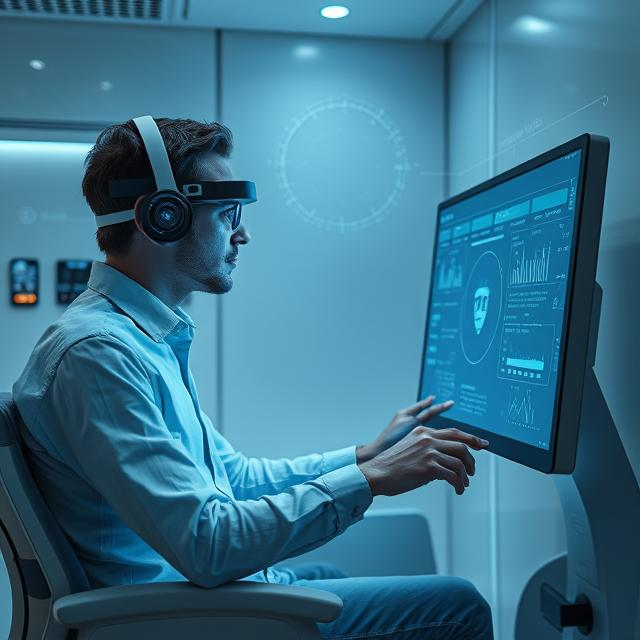In today’s fast-changing tech world, Blue Eyes technology stands out as a game-changing step forward in how humans and computers work together. By copying what humans can sense, it aims to shake up the way we use machines making it feel more natural and easy. In this post, we’ll take a close look at Blue Eyes technology checking out its parts where it might be used, and the exciting things it could bring in the future.
What is Blue Eyes Technology?
Blue Eyes technology combines hardware and software to give machines human-like perception. It aims to build computers and systems that understand and react to users like humans do. You can think of it as the next step in making machines more aware of how we feel, what we want, and what we do.
At its heart, Blue Eyes technology uses cameras, microphones, and sensors to collect sensory data from the user. Smart algorithms then process this data to figure out the user’s intentions, emotions, and actions. This back-and-forth allows for more natural and responsive interactions between humans and machines.
Core Components of Blue Eyes Technology:
- Cameras: These capture visual data, like facial expressions, eye movements, and gestures. This allows the system to recognize users’ feelings or what they’re trying to say.
- Microphones: Audio data plays a key role in speech recognition. Microphones in Blue Eyes systems pick up not just our words, but also our voice tone and pitch. This helps the system grasp emotions and context.
- Sensors: These devices gather extra physical data such as heart rate, skin conductivity, and body temperature. This info can offer useful insights into a user’s emotional state or health condition.
- Software: The software part handles all the data it gets and figures out what the user wants. It then comes up with the right way for the machine to respond making sure the reaction fits the situation.
Applications of Blue Eyes Technology
Blue Eyes technology has many potential uses across different fields. Let’s look at some exciting areas where this technology could have a big impact:
1. Accessibility
One of the most promising ways to use Blue Eyes technology is to help people with disabilities. This technology can make a real difference for those who have trouble moving. It lets them control computers by tracking their eyes and recognizing gestures. Blue Eyes can pick up on specific hand movements or even patterns in how someone looks at a screen. This means people can use devices more and , which gives a big boost to accessibility.
2. Gaming
Picture a gaming world where the game reacts to your feelings as well as your actions. Blue Eyes tech can build engaging game settings that respond to your facial expressions how your eyes move, and even shifts in your heart rate. This kind of interaction could result in games that change based on how you feel or how involved you are giving you a more tailored and lively gaming experience.
3. Automotive
In the car industry, Blue Eyes technology has an impact on making driving safer. Advanced driver assistance systems (ADAS) could keep an eye on a driver’s face and eyes to spot signs of tiredness, lack of focus, or anxiety. By looking at small clues like how often someone blinks or changes in their facial expressions, the system could warn the driver if they’re getting too sleepy or distracted helping to stop crashes.
4. Healthcare
Healthcare is another area where Blue Eyes technology could cause a revolution in the industry. By examining patients’ facial expressions, gestures, and even physical data, doctors and nurses could gain useful insights into a patient’s emotional state and health. For instance, a doctor could check a patient’s stress level through heart rate and skin conductivity data resulting in more precise diagnoses and improved treatment plans.
5. Customer Service
Blue Eyes technology can also improve customer service experiences. By spotting customer emotions through facial expressions and voice tone, companies can adjust interactions to create a more personal and caring experience. Whether in shops, hotels, or online help desks understanding how customers feel can result in more effective solutions and stronger relationships with customers.
Challenges and Future Directions
While Blue Eyes technology has great promise, it faces several hurdles before it can reach its full potential.
1. Data Privacy and Security
Blue Eyes systems gather very personal information, including emotional and body data. This makes protecting user privacy and data security essential. Companies must put strong safeguards in place to keep sensitive user information safe from misuse or theft.
2. Algorithm Accuracy
interpreting data from cameras, microphones, and sensors presents a big challenge. We need to improve current algorithms to make sure they can understand complex human behaviors and emotions . Wrong interpretations could result in incorrect responses or even annoy users.
3. Ethical Concerns
Emotion recognition, in particular, brings up ethical questions about consent and privacy. If systems can read and respond to emotions, we need to think about what this means for personal freedom and privacy. Users might not always feel okay with machines analyzing their emotions, so we’ll need clear consent processes and ethical guidelines.
The Future of Blue Eyes Technology
Even with these hurdles, Blue Eyes technology has a promising future ahead. As AI learning, computer sight, and sensor tech keep getting better, we can expect to see even more advanced and well-integrated systems. These will combine what humans and machines can do
